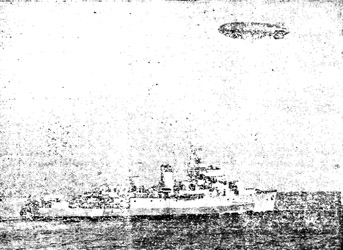Sunday Times of Malta
9th December 1945 Pages 5 & 12
MEN WHO SWEEP THE SEAS
Their Contribution To Battle Of The Peace
ALLIED COOPERATION AT SEA
by F. Hudson, "Times of Malta" staff reporter and photographer
Last week's opening article in the "Sunday Times of Malta" dealt with the 19th Minesweeping Flotilla's record in the Mediterranean where the flotilla has close on 1700 mines to its credit. The flotilla, while operating in the Northern Adriatic and off Malta has been assisted by a United States Navy "K" type blimp, under the command of Lieutentant Gordon S. Bodek, U.S. Naval Reserve.
United States Navy blimps (official designation: non-rigid lighter than air airships) began close cooperation with the Royal Navy's minesweepers during the invasion of Italy, although they were first adapted to this work during the invasion of Southern France where they were operating only some 60 miles or so from enemy held airfields.
HIGHLY VULNERABLE TO TO AIR ATTACK THEY WERE, NEVERTHELESS, ABLE TO 'COCK A SNOOT' AT A CHAGRINED LUFTWAFFE GROUNDED BY ALLIED AIR SUPERIORITY AND LACK OF FIGHTER AIRCRAFT.
FIRST TRANS-ATLANTIC CROSSING
Blimpron Squadron 14 flew the first trans-atlantic crossing of non-rigid airships in May 1944. Their original role was that of anti-submarine patrol, a task which, in addition to convoy escort and air-sea rescue work, they carried out with a great measure of success on America's Western and Eastern seaboards.
Powered by two Pratt and Whitney 550 h.p. petrol engines, the "K" type have an overall length of 256 ft., a theoretical ceiling of 10,000 ft., and a range, given favourable weather, of close on 2,000 miles. Filled with non-inflammable helium (a United States monopoly, although small quantities are to be found in the Russian Urals) the bag has a helium capacity of 450,000 cubic feet.
 |
 |
| The blimp is controlled by two pilots, one (left) controller the elevator, and the other (right) controlling the rudder. Figure (centre) is the Royal Navy liaison officer busy minespotting. Nose of the gondola affords a completely unobstucted view over a wide area. |
LARGER AND SMALLER TYPES
There are larger and smaller types. "L" type with a helium capacity of 129,000 cubic feet, is used as a primary trainer. (It is of interest to note here that pilots, before commencing their course in blimp flying, must have first passed a civilian pilot's flying test.) There follows the "G" type blimp for photo and torpedo reconnaissance. The "K" type and finally the "M" type, with an overall length of 312 ft., and a helium capacity of 750,000 cubic feet. They were used primarily for long-range patrol work, but are now operating as air-sea rescue units and on utility missions.
IN THE AIR 24 HOURS:
The "K" type blimp can stay in the air 24 hours, if necessary. There is accommodation for ten in the 40 ft., long gondola including four officer pilots - all qualified navigators - two aviation mechanics, two radiomen and two airship riggers, and despite the enormous amount of technical equipment carried there is, in addition, an electric cooking stove, water tanks and a washing sink and two hammocks.
ADVANTAGE OVER AIRCRFT:
With a cruising speed of 50 knots and a top speed of 75 knots, the advantage of the blimp over the aircraft for minespotting work is that it can operate at a very low speed and even hover or come to a complete stop.
PATROLLED STRAITS OF GIBRALTER:
After crossing the Atlantic, Blimpron Squadron 14, under Commander Sullivan, (now Captain) U.S. Navy, and numbering originally some 75 officers and 225 enlisted men, set up base at Port Lyautey, French Morocco, from where, equipped with depth charges, contact bombs, radar equipment that will pick up a surfaced submarine and additional equipment that will even seek out and follow a submarine beneath the surface, the squadron carried out anti-submarine patrols by night over the Straits of Gibraltar. Though official facts and figures have not yet been releaased by the United States Navy authorities, their presence is known to have brought about a virtual stoppage in enemy submarine traffic.
The squadron is also credited with having saved a number of unescorted merchant ships and even minesweepers from running into drifting mines and, in one instanc, of having diverted a troopship at the crucial moment by dropping flares.
Following the successful invasion of Southern France,and while still retaining their headquarters at Port Lyautey, the squadron dispersed over the Western Mediterranean to assist in minesweeping and the blimps were eventually based as far afield as Oran, Bizerta, Rome, Pisa, Venice and, ultimately, Malta.
COOPERATION AT SEA:
At sea the blimp operates either in "close cooperation" with the minesweepers, or proceeds on an "independent search." That is to say, it will either proceed to patrol ahead of the sweepers, keeping a sharp look-out for mines - and it is possible to see them as bluish-white circular blobs apparently on the surface, although they are possibly several fathoms below (this is an illusion created by altitude) - or it will proceed to cover laps as yet unswept by the sweeper. At all times the blimp is in radio-telephone contact with the sweepers. Should a mine be sighted a button to the hand of one of the pilots releases a smoke flare that will drop in close proximity to the mine which is then disposed of by the oncoming sweepers. When several mines are spotted their position is charted by the liaison officer and the information radioed to the flotilla commander. Occasionally one gets a "false alarm" when a sun-bathing turtle is mistaken for a mine. A smoke flare in his visibility or the noise of approaching aero engines will cause him to strike out smartly for "home."
 |
 |
| Coming in at an altitude of 400 ft. the U.S. Navy's minespotting blimp radios a cheery good morning to Rinaldo, Commander F.S.Walford, R.N., flotilla leader of the 19th Minesweeping Flotilla. A "swoop" on Waterwitch, Lieutenant-Commander W.G. Pitcher, R.N.R. |
OPERATIONS FROM MALTA:
Since the blimp's arrival in Malta I have had the privilege of accompanying the crew on several of their operational trips. The take-off, in comparison with that of an aircraft is surpsingly short. In next to no time you are in the air and gaining height rapidly. Levelling out at the required altitude and settling down to a cruising speed of some 50 knots, Malta's terraced hillsides and criss-crossed valleys (that seem to be the dominant impression from the air) are soon left behind as the blimp points her nose seawards and speeds for her rendezvous with the minesweeping flotilla.
The landing operation on the other hand, requires the most experienced handling and a landing party of some 40 men, 15 or so to each guide rope, is necessary before the blimp is "nursed" nose first to her 12 ton mooring mast.
Owing to the enoormous bulk a gusty wind is likely to lengthen the normal 10 minute landing operation into something like half an hour, but, on the other hand it should not be thought that through this blimps are "fair weather" aircraft only. They have, I am told, been flown in the teeth of raging gales and have only been laid off from minespotting when the sea was too choppy for them to be of any service to the sweepers
Since this article was written the United States Navy minespotting detachment has left Malta for home and demobilization. Our good wishes and gratitude for a task well done go with them.
One of our captions last week erroneously described Lieutenant Bean, R.N.V.R. as navigator aboard the blimp. He is, of course, liaison officer and the actiual navigation is carried out by United States Navy pilots |






